Tamron SP 24-70 mm f/2.8 Di VC USD
5. Chromatic and spherical aberration
Chromatic aberration
The longitudinal chromatic aberration is not a problem for the tested lens. Crops, shown below, are the proof.
 |
Please Support UsIf you enjoy our reviews and articles, and you want us to continue our work please, support our website by donating through PayPal. The funds are going to be used for paying our editorial team, renting servers, and equipping our testing studio; only that way we will be able to continue providing you interesting content for free. |
- - - - - - - - - - - - - - - - - - - - - - - - - - - - - - - - - - - - - - - - - - - - - - - -
When it comes to the lateral chromatic aberration it can be bothersome only at the shortest focal length and near the maximum relative aperture. Its level is significant there but fortunately at other combinations of apertures and focal lengths it is not felt almost at all. The graphs below show how the lens fares on the edge of the APS-C/DX sensor and on the edge of full frame.
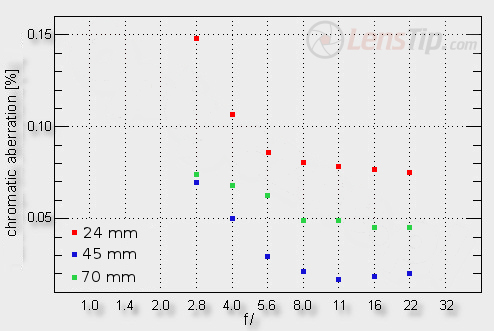
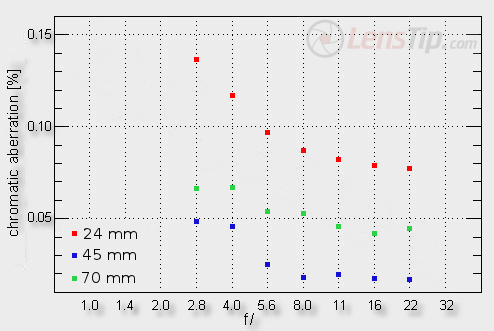
How does the Tamron compare with its competitors here? A duel with the Sigma ends in a draw as the Sigma presents similar values. The Nikkor and the old Canon have a win over the Tamron though. Although their results at longer focal lengths are similar, they don’t have such a high chromatic aberration level at 24 mm and by f/2.8.
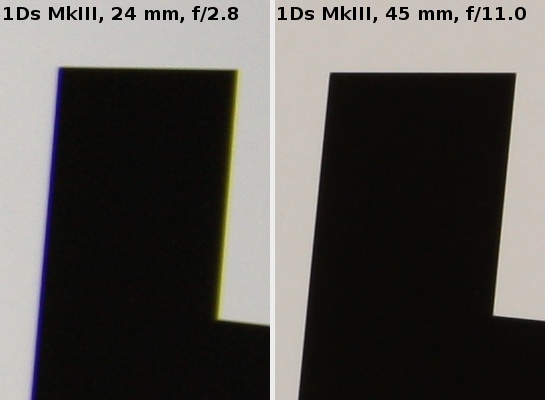 |
Spherical aberration
The spherical aberration must be discussed at greater length here because it is a huge problem of the tested lens, especially visible at 70 mm. Its first effect is the so-called focus shift which is presented in crops below.
 |
We did it as follows: first we set the focus by f/2.8 very precisely and then the lens was switched to the manual mode and we took photos for the successive apertures. It can be noticed that the sharpness by f/2.8 is set correctly and the depth of field is spread evenly in front of and behind the focal point. By f/5.6 the situation is quite different though- there is much more of sharp area behind the focus. What’s more the number 3, situated in front of the focus, seems to be a bit sharper in the f/2.8 than in the f/5.6 photo. In the photo taken by f/11 the same number 3 is as sharp as by f/2.8 whereas the image situated behind the focus seems to be situated almost completely inside the depth of field which, by this aperture, is huge.
You can assess how serious that problem can be by comparing two series of shots of our focus chart. The first one (blue dots) was created exactly like the photos with the focus shift. We set the focus as precisely as we could by f/2.8 and the images by other apertures were taken in the manual mode without changing the position of the focus. The series with the red dots was created by setting the focus manually in the best possible way but separately for each aperture value.
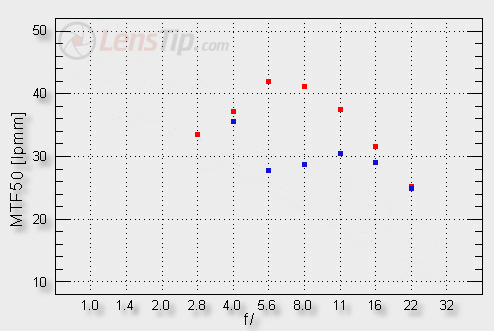
It can be clearly noticed that the increase of the level of spherical aberration is not linear. Its influence on f/4.0 remains still slight but it becomes significant on further stopping down.
Such an aberration is bothersome. The autofocus works well by f/2.8 maximum aperture and the settings allow you to take more or less sharp photos only by f/2.8 and f/4.0. On further stopping down by every aperture value you must correct the focus differently – otherwise the photos won’t be of a sufficient quality. Perhaps some software, downloaded by a customer service from the site of the producer of this lens, might help, ‘teaching’ the set of a body and the tested lens how to correct the autofocus depending on the used aperture values. Unfortunately we don’t know whether it is possible at all or whether such software already exists.
At the end of the spherical aberration chapter let’s look at defocused images of a point-like source of light, got in front of and behind the focus.
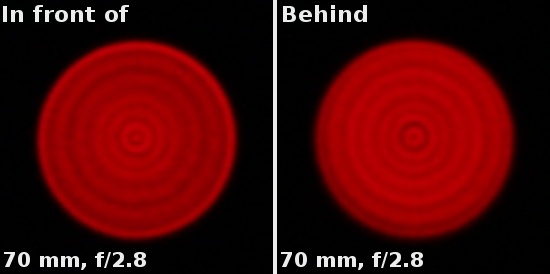 |
First of all in both cases you see pronounced concentric rings of light with changeable intensity. What’s more, in the case of the first image its lightness decreases when you move away from the centre and in the second image it distinctly increases. It is another argument for the existence of a noticeable spherical aberration at 70 mm.






